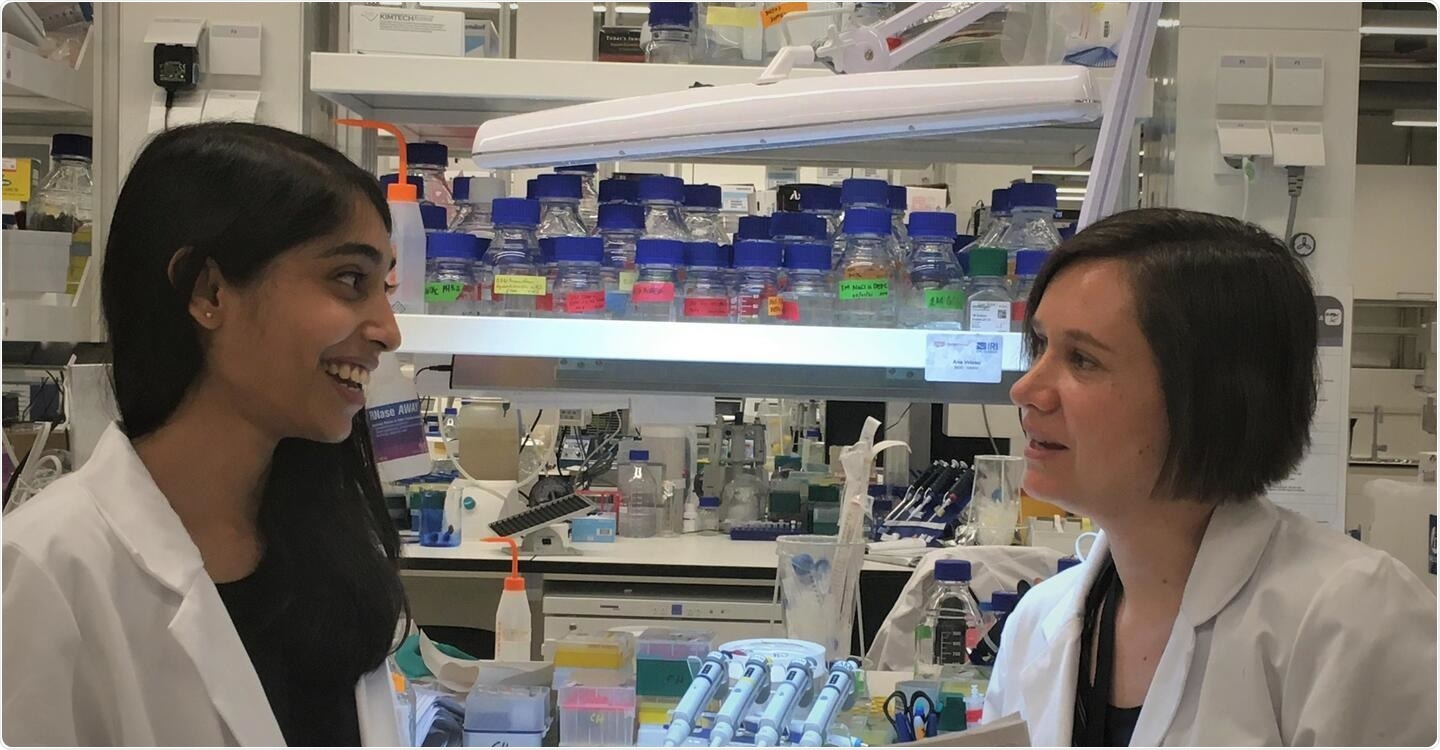Reviewed by Dan Hutchins, M.PhilSep 16 2021
Charcot-Marie-Tooth disease (CMT), a rare hereditary condition, commences when genetic changes interrupt the transmission of nerve signals from the brain to the muscles of the extremities, specifically those of the lower limbs. This results in a gradual loss of muscle tissue in the lower legs.

Samantha Mendonsa (left) and Marina Chekulaeva (right) in the lab at BIMSB/MDC. Image Credit: Chekulaeva Lab, Max Delbrück Center for Molecular Medicine in the Helmholtz Association.
Initial symptoms of the disease include pain and difficulties in walking, which mostly show up in childhood and adolescence. It is estimated that in Germany alone around 30,000 individuals are living with CMT.
Enzymes become altered
We have known for some time that mutations in genes encoding enzymes called aminoacyl-tRNA synthetases (aaRSs) can cause CMT.”
Dr Marina Chekulaeva, Head, Non-coding RNAs and Mechanisms of Cytoplasmic Gene Regulation Lab, Berlin Institute for Medical Systems Biology
The Berlin Institute for Medical Systems Biology (BIMSB) is part of the Berlin-based Max Delbrück Center for Molecular Medicine in the Helmholtz Association (MDC).
These enzymes are necessary for cellular protein production, which occurs in the ribosomes—the cell’s protein factories. Ribosomes perform aminoacylation-binding of an amino acid to another molecule, what is called tRNA. This allows the individual amino acids to be bound together at the ribosomes to form a protein chain according to the genetic blueprint stored in the DNA.
Translation is impaired by mutations
The paradox is that these mutations do not disrupt aminoacylation activity, but they do interfere with translation—the production of proteins at the ribosomes. To understand this mechanism, my team and I took a close look at how mutations in glycyl-tRNA synthetase affect translation processes.”
Dr Marina Chekulaeva, Head, Non-coding RNAs and Mechanisms of Cytoplasmic Gene Regulation Lab, Berlin Institute for Medical Systems Biology
In patients with a common form of CMT disease called CMT type 2D (CMT2D), this enzyme is altered. The scientists, for their research, employed ribosome profiling to extensively analyze ribosomal activity.
This technique helps us determine things like the exact codon where protein production is halted, and quantify the frequency at which this occurs.”
Samantha Mendonsa, Study First Author and Doctoral Student, Max Delbrück Center for Molecular Medicine in the Helmholtz Association
Protein chains are too short
Mendonsa, who is a doctoral student in Chekulaeva’s lab, further adds, “We found that the gene alteration in CMT patients initially results in a shortage of glycyl-tRNA available for translation. This causes ribosomes to stall their protein production at the sites where the amino acid glycine is to be added to the growing protein chain.”
This halts the elongation or lengthening of the protein chain. “The pause in elongation at the glycine sites also induces an integrated stress response, leading to a disruption of translation initiation,” she stated. Consequently, protein production decreases.
Researchers Mendonsa and Chekulaeva believe that their observations can offer new avenues for therapies against CMT, for which there is no causal treatment at present.
Chekulaeva asserts, “One possibility would be the administration of tRNA to overcome its shortage in the nerve cells, thus alleviating ribosome pausing. Another approach could be to use relevant therapeutic agents to suppress the integrated stress response.”
Furthermore, she states that following these avenues further is at present a task for clinical researchers.
Open questions
“Our team is now interested, for example, in the still unanswered question of how and why ribosome pausing impairs the function of the motor and sensory nerve fibers that connect the brain and lower limbs,” remarks Chekulaeva.
An explanation to the question will probably be of huge benefit to individuals with CMT.
Source:
Journal reference:
Mendonsa, S., et al. (2021) Charcot–Marie–Tooth mutation in glycyl-tRNA synthetase stalls ribosomes in a pre-accommodation state and activates integrated stress response. Nucleic Acids Research. doi.org/10.1093/nar/gkab730.